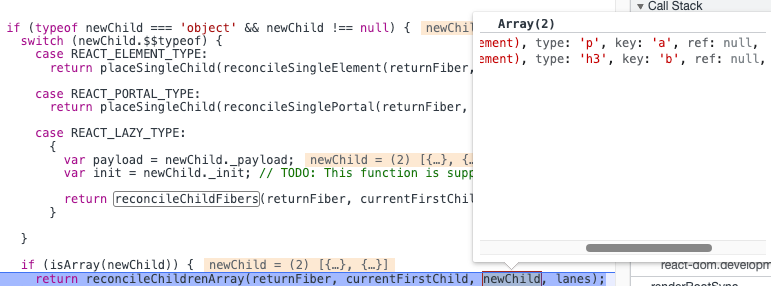多节点 Diff 算法
前言
在上一节,我们知道了 React 是如何对单节点进行 Diff 的,逻辑很简单,判断 key 和 type 即可,而对于 多节点而言,也就是 Array 而言,在场景上也就是将一个或多个 Fiber 替换成多个 Fiber,处理起来会复杂很多
这种情况下,reconcileChildFibers 的 newChild 参数类型为 Array,在 reconcileChildFibers 函数内部会进入下面的 if 中,从而处理 array 多节点的 diff
if (isArray(newChild)) {
// 调用 reconcileChildrenArray 处理
// ...省略
}如下图 newChild 为新的节点,是 Array 类型的
Diff 的思路
首先我们先看看一共有哪些情况需要被处理:节点更新、节点增加、节点减少、节点位置变化等
在实际的场景中,节点更新使用的场景会更加高一些,因此 React 中会优先处理节点更新的情况
在 reconcileChildrenArray的参数中,currentFirstChild是 FiberNode 也就是链表的结构,newChild则是一个 JSX 对象,因此我们对比的是一个链表和一个数组
虽然本次更新的 JSX 对象
newChildren为数组形式,但是和newChildren中每个组件进行比较的是current fiber,同级的 Fiber 节点是由 sibling 指针链接形成的单链表,即不支持双指针遍历。 即newChildren[0]与fiber比较,newChildren[1]与fiber.sibling比较。 所以无法使用双指针优化。
因此,基于此原因, Diff 算法采用两轮遍历:
第一轮遍历:处理更新的节点
第二轮遍历:处理剩下的不属于更新的节点
第一轮遍历
第一轮遍历主要处理的是更新的逻辑
遍历 newChildren,将 newChildren[i] 与 oldFiber进行比较,判断是否可以复用
Diff 的逻辑存在于 updateSlot 这个方法中,这个方法的逻辑和 reconcileSingleElement 非常像,如果 key 不同会返回 null,key 相同会返回新的 Fiber 节点
调用 updateSlot 来 diff oldFiber 和 新的child,生成新的fiber
function updateSlot( returnFiber: Fiber, oldFiber: Fiber | null, newChild: any,lanes: Lanes,): Fiber | null {
const key = oldFiber !== null ? oldFiber.key : null;
// ...
// 处理 react Element
if (typeof newChild === 'object' && newChild !== null) {
switch (newChild.$$typeof) {
case REACT_ELEMENT_TYPE: {
if (newChild.key === key) {
return updateElement(returnFiber, oldFiber, newChild, lanes);
} else {
return null;
}
}
//...
}
return null;
}1. key 不同跳出遍历
当 updateSlot 的返回值是 null 时,会跳出第一轮循环
这也说明了,oldFiber 和 newIdx 为下标的 newChild 的 key 不同,说明 oldFiber 不能复用
if (newFiber === null) {
if (oldFiber === null) {
oldFiber = nextOldFiber;
}
break;
}2. key 相同 type 不同
当 key 相同时,会进入 switch case 中的 if 逻辑,执行 updateElement 方法,type 不同而执行 createFiberFromElement方法,生成新的 Fiber
function updateElement(
returnFiber: Fiber,
current: Fiber | null,
element: ReactElement,
lanes: Lanes,
): Fiber {
const elementType = element.type;
// ...
if (current !== null) {
if (current.elementType === elementType ){
// type 相同逻辑
}
}
// type 不同
const created = createFiberFromElement(element, returnFiber.mode, lanes);
created.ref = coerceRef(returnFiber, current, element);
created.return = returnFiber;
return created;
}因此此时的 newFiber 为新创建的这个 Fiber 节点,如果是在 update 阶段,会进入下面 if 的逻辑,newFiber 的 alternate 指针为 null ,将 oldFiber 标记删除
if (shouldTrackSideEffects) {
if (oldFiber && newFiber.alternate === null) {
deleteChild(returnFiber, oldFiber);
}
}创建了新的 Fiber 节点,我们需要为新的 Fiber 节点赋值一个 placement 的 effectTag ,这样在 commit 阶段才会更新 DOM 插入到 DOM Tree 中
function placeChild(
newFiber: Fiber,
lastPlacedIndex: number,
newIndex: number,
): number {
// 新节点插入的索引
newFiber.index = newIndex;
// ...
const current = newFiber.alternate;
// 先判断是不是 update
if (current !== null) {
const oldIndex = current.index;
if (oldIndex < lastPlacedIndex) {
// This is a move.
newFiber.flags |= Placement;
return lastPlacedIndex;
} else {
// This item can stay in place.
return oldIndex;
}
} else {
// 新创建的 fiber 节点,alternate 为 null,赋值 placement 的 effectTag
newFiber.flags |= Placement;
// lastPlacedIndex 代表本次更新的节点在 DOM 中的位置
return lastPlacedIndex;
}
}然后将本次 Diff 生成的新节点与上一个新节点建立连接,也就是 sibling 指针指向
之后开始对下一个 oldFiber 进行 Diff
lastPlacedIndex = placeChild(newFiber, lastPlacedIndex, newIdx);
if (previousNewFiber === null) {
// 标识为 新节点的第一个
resultingFirstChild = newFiber;
} else {
// 和前一个新节点连接
previousNewFiber.sibling = newFiber;
}
previousNewFiber = newFiber;
oldFiber = nextOldFiber;3. 遍历完成跳出遍历
1. newChildren 遍历完成,oldFiber 未遍历完成
如果 newChildren 遍历完成,而 oldFiber 还没遍历完成,那么剩下的所有 oldFiber 都需要被删除
通过 deleteRemainingChildren 函数来对,所有的 oldFiber 节点进行删除
if (newIdx === newChildren.length) {
deleteRemainingChildren(returnFiber, oldFiber);
return resultingFirstChild;
}2. oldFiber 遍历完成,newChildren 未遍历完成
如果是这种情况,需要剩余的 newChildren 全都是需要新增的节点,那就继续遍历 newChildren的剩余节点,调用 createChild 方法来生成新的 Fiber 节点,然后调用 placeChild 来打上 PlaceMent 的 effectTag ,然后建立 sibling 的连接,与 Fiber 树进行关联
if (oldFiber === null) {
// If we don't have any more existing children we can choose a fast path
// since the rest will all be insertions.
for (; newIdx < newChildren.length; newIdx++) {
// 创建 Fiber
const newFiber = createChild(returnFiber, newChildren[newIdx], lanes);
if (newFiber === null) {
continue;
}
// 添加 effectTag
lastPlacedIndex = placeChild(newFiber, lastPlacedIndex, newIdx);
// 连接 Fiber 树
if (previousNewFiber === null) {
// TODO: Move out of the loop. This only happens for the first run.
resultingFirstChild = newFiber;
} else {
previousNewFiber.sibling = newFiber;
}
previousNewFiber = newFiber;
}
...
return resultingFirstChild;
}3. 如果 oldFiber 和 newChildren 都没有遍历完成
这意味着有节点在本次更新中改变了位置
为了在 O(1) 复杂度内,找到 key 对应的 oldFiber 节点,通过 mapRemainingChildren 函数创建一个以 oldFiber 的 key 为键,oldFiber 为值的 Map 数据结构, 将所有未处理的 oldFiber 存入 key --> FiberNode 的 Map 中
const existingChildren = mapRemainingChildren(returnFiber, oldFiber);第二轮遍历
只有在 oldFiber 和 newChildren 都没有遍历完成的情况下,才会进入第二轮遍历,遍历是基于生成的 Map 数据结构 existingChildren 进行的。
遍历 newChildren,通过 updateFromMap 函数从 Map(existingChildren) 中找到具有相同 key 的 oldFiber
for (; newIdx < newChildren.length; newIdx++) {
const newFiber = updateFromMap(
existingChildren,
returnFiber,
newIdx,
newChildren[newIdx],
lanes,
);
if (newFiber !== null) {
// update 阶段,从 map 中删除 oldFiber
if (shouldTrackSideEffects) {
if (newFiber.alternate !== null) {
existingChildren.delete(
newFiber.key === null ? newIdx : newFiber.key,
);
}
}
// 打上 placeMent 的 effectTag
lastPlacedIndex = placeChild(newFiber, lastPlacedIndex, newIdx);
// 建立 Fiber 连接
if (previousNewFiber === null) {
resultingFirstChild = newFiber;
} else {
previousNewFiber.sibling = newFiber;
}
previousNewFiber = newFiber;
}
}- 如果找到了,则基于
oldFiber和newChildren的props创建新的fiber,然后从Map中删除该oldFiber,打上 PlaceMent 的 effectTag,并将新生成 Fiber 与 Fiber 树建立连接
需要注意的是,这次的 placeChild 中,我们需要关注它的核心逻辑
- 当
oldIndex < lastPlacedIndex时,表示该可复用节点之前的位置索引小于这次更新需要插入的位置索引,代表该节点需要向右移动 - 如果
oldIndex >= lastPlacedIndex代表该可复用节点不需要移动
function placeChild(
...
const oldIndex = current.index;
if (oldIndex < lastPlacedIndex) {
// This is a move.
newFiber.flags |= Placement;
return lastPlacedIndex;
} else {
// This item can stay in place.
return oldIndex;
}
...
}如果在 newChildren 遍历完成后,map 中还有值,则需要全部进行删除标记,因为在 newChildren 中已经不存在了
if (shouldTrackSideEffects) {
existingChildren.forEach(child => deleteChild(returnFiber, child));
}至此,reconcileChildArray 流程已经全部走完,多节点 Diff 的逻辑已经全部讲解完毕!